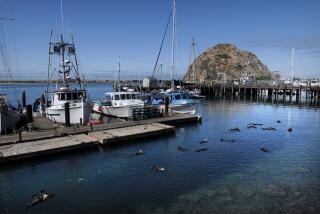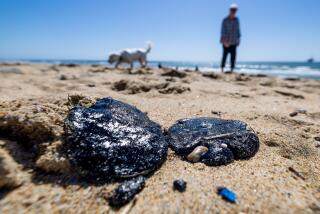Crews Focus on Oil Settled in Jetty Rocks
- Share via
HUNTINGTON BEACH — As cleanup costs for the Orange County oil spill topped $12 million, biologists warned Friday that Alaskan crude still buried on beaches and trapped in rock jetties may threaten a nearby wildlife marsh for weeks or months.
Biologists also reported that, for the first time since the Feb. 7 spill, a sheen of oil residue entered the Huntington Beach wetlands earlier this week. Although county officials have rebuilt a 15-foot-high earthen dike to block oil-fouled high tides from reaching the 25-acre marsh near the Santa Ana River mouth, about 100 feet of the 25-acre marsh may have already been damaged.
State fish and game experts said oil that seeped into the wetlands came from nearby jetties, where thick pools of black crude have settled in rock crevasses that are nearly impossible to clean.
The jetties mark the entrance to the river mouth and two adjacent channels, including the Talbert Channel that leads to the wetlands that environmentalists consider among the most significant on the Orange County coast.
“There’s still a lot of oil in those jetties, and the incoming tides and waves keep leeching it out,” said biologist Gordon Smith, chairman of the Huntington Beach Wetlands Conservancy. “It’s going to be a problem for some time. . . . The cleanup is far from over.”
As concern focused Friday on the Santa Ana River jetties and the nearby wetlands, cleanup officials walked much of a 10-mile stretch of shore from Bolsa Chica State Beach near Warner Avenue to the Newport Pier, assessing damage and the cleanup efforts.
At the same time, officials in Huntington Beach and Newport Beach prepared today for a possible onslaught of beach-goers and oil gawkers, drawn to the coast by warm, spring-like weather.
Sightseers, however, will find beach parking lots closed and access to the sand sealed off by yellow police tape, as cleanup crews tackle the remnants of the 394,000-gallon spill from the ruptured tanker American Trader.
The 10-mile strip of beach is closed for health and safety reasons. Officials warned that the ban will be strictly enforced, with violators being ticketed by police and lifeguards.
“There will be no exceptions,” Newport Beach marine safety officer Dave Wenger said. “We had a lot of disappointed people (Friday) who were turned away. I expect more of the same over the weekend.”
Officials with British Petroleum, which owned the oil, announced Friday that the cleanup has so far cost the company $12 million, most of it for the 1,400-worker force that was marshaled on the beach when the slick reached shore last week.
In Sacramento, meanwhile, Lt. Gov. Leo T. McCarthy announced that the three-member State Lands Commission will investigate the tanker accident during a hearing March 7 in Huntington Beach. The commission regulates offshore oil leases and related activities in state waters three miles out from the coast.
McCarthy also said the proposed Oil Spill Prevention and Response Act will be amended to double fines assessed to owners of single-hulled tankers involved in oil spills. If adopted, the fine for a vessel such as the American Trader would be $20 per gallon spilled, and $60 if the spill was caused through “gross negligence.”
An Assembly committee is reviewing the legislation, which would also create several new oil spill control programs and a $500-million response fund.
In Huntington Beach, cleanup officials met to establish guidelines for reopening beaches. Discovery of oil embedded up to 12 inches deep in sand above the high tide line has raised concerns about the cleanup’s effectiveness and long-term safety to the public once the shoreline is reopened.
Although no firm policy was adopted, Coast Guard Capt. James C. Card said after the meeting that the beaches will remain off limits until “all the oil that can be removed is removed.”
The general criteria officials will rely upon in deciding whether to reopen a beach will be “when you don’t see, feel or smell any oil,” he added.
With most of the surface oil mopped up, cleanup workers Friday used varied techniques to scoop up the crude hidden below the surface. Along Bolsa Chica State Beach, so-called sanitizer machines separated sand from tar balls, while tractors plowed up sand on the north side of the Huntington Beach Pier to expose oil globs to sunlight and oxygen, in hope that the crude will eventually evaporate.
“The beaches themselves--from Warner Avenue to Beach Boulevard--are in as good a shape as they’ve been” since the spill, Huntington Beach Fire Chief Raymond C. Picard said.
Picard, however, said in some areas, particularly near the Santa Ana River mouth, “we’re still tasting, feeling and seeing oil.”
Across the Talbert Channel, just east of the Santa Ana River, bulldozers on Friday rebuilt the sand dike washed out by last week’s rain. Biologist Smith said the dike is needed because a thin layer of oil has reached the fringe of the Huntington Beach wetlands and threatened to contaminate the mud flats in the marsh, where shore birds feed.
A culvert with a metal flap was installed at the base of the dike so rainwater from the river channel can push its way out but tainted seawater cannot flow back in. Officials hope that the culvert will be an effective alternative to the hole they had to punch in the berm to release runoff during last weekend’s storm.
Meanwhile, California Department of Fish and Game officials approved using a water solution heated to 190 degrees to clean the stubborn oil coating the jetties. A similar approach is being used on the rocks dotting the shoreline in Newport Beach, but that solution can be no hotter than 90 degrees--a temperature considered safe for crabs, starfish and other marine life among the rocks.
But Smith said the oil residue is so thick on jetties near the river mouth that any marine animals still in the breakwater are probably in “sad shape.” Thus, using the hotter solution, sprayed from a pressurized hose, is a trade-off to save the wetlands, home to dozens of species of waterfowl.
“It’s a choice between what life might be left in the rocks and a tidal marsh that has not been touched by oil,” Smith said. “It’s most important to save the marsh.”
Greg Hernandez contributed to this report.
More to Read
Sign up for Essential California
The most important California stories and recommendations in your inbox every morning.
You may occasionally receive promotional content from the Los Angeles Times.










